HSA 4421: Government Regulations and Agencies in US Healthcare
VerifiedAdded on 2023/04/10
|9
|2013
|65
Report
AI Summary
This report provides an in-depth analysis of the Agency for Healthcare Research and Quality (AHRQ) and the Agency for Toxic Substances and Disease Registry (ATSDR), two key regulatory agencies within the U.S. Department of Health. It explores their respective backgrounds, missions, regulatory responsibilities, divisions, and impacts on the healthcare system. The report details AHRQ's focus on improving the safety, quality, accessibility, and affordability of healthcare, along with its efforts to set quality standards and regulate healthcare information. It also examines ATSDR's role in safeguarding public health from hazardous substances, including its responsibilities under the Superfund Act and its divisions focused on community health investigations and toxicology. The analysis highlights the impact of both agencies on hospital systems, outpatient care, emergency response, and reducing healthcare costs associated with toxic exposures. The report concludes by emphasizing the importance of strengthening these institutions to further enhance their contributions to the U.S. health sector.

Running head: GOVERNMENT REGULATIONS AND REGULATORY AGENCIES 1
Government Regulations and Regulatory Agencies
HAS 4421
Team Member Names
Government Regulations and Regulatory Agencies
HAS 4421
Team Member Names
Paraphrase This Document
Need a fresh take? Get an instant paraphrase of this document with our AI Paraphraser
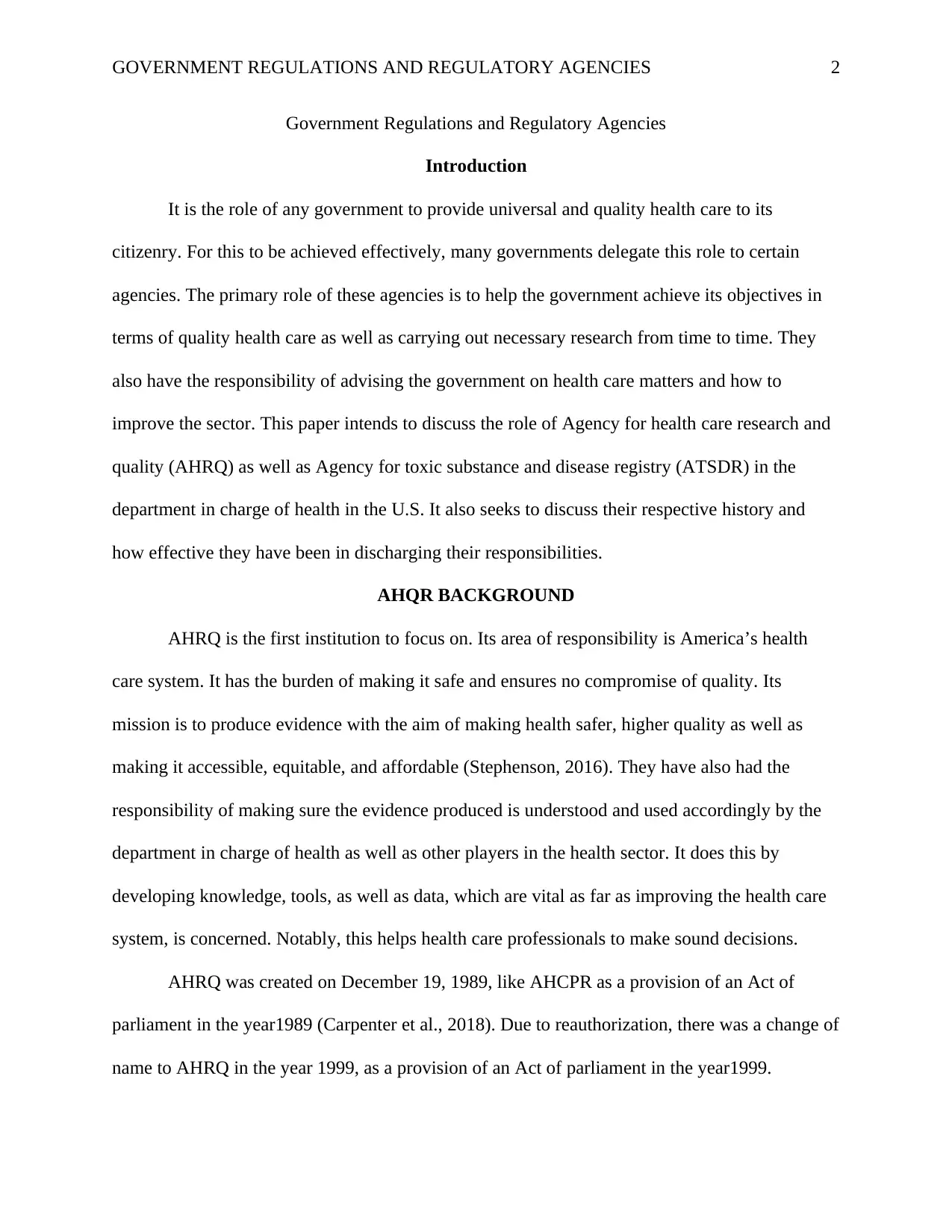
GOVERNMENT REGULATIONS AND REGULATORY AGENCIES 2
Government Regulations and Regulatory Agencies
Introduction
It is the role of any government to provide universal and quality health care to its
citizenry. For this to be achieved effectively, many governments delegate this role to certain
agencies. The primary role of these agencies is to help the government achieve its objectives in
terms of quality health care as well as carrying out necessary research from time to time. They
also have the responsibility of advising the government on health care matters and how to
improve the sector. This paper intends to discuss the role of Agency for health care research and
quality (AHRQ) as well as Agency for toxic substance and disease registry (ATSDR) in the
department in charge of health in the U.S. It also seeks to discuss their respective history and
how effective they have been in discharging their responsibilities.
AHQR BACKGROUND
AHRQ is the first institution to focus on. Its area of responsibility is America’s health
care system. It has the burden of making it safe and ensures no compromise of quality. Its
mission is to produce evidence with the aim of making health safer, higher quality as well as
making it accessible, equitable, and affordable (Stephenson, 2016). They have also had the
responsibility of making sure the evidence produced is understood and used accordingly by the
department in charge of health as well as other players in the health sector. It does this by
developing knowledge, tools, as well as data, which are vital as far as improving the health care
system, is concerned. Notably, this helps health care professionals to make sound decisions.
AHRQ was created on December 19, 1989, like AHCPR as a provision of an Act of
parliament in the year1989 (Carpenter et al., 2018). Due to reauthorization, there was a change of
name to AHRQ in the year 1999, as a provision of an Act of parliament in the year1999.
Government Regulations and Regulatory Agencies
Introduction
It is the role of any government to provide universal and quality health care to its
citizenry. For this to be achieved effectively, many governments delegate this role to certain
agencies. The primary role of these agencies is to help the government achieve its objectives in
terms of quality health care as well as carrying out necessary research from time to time. They
also have the responsibility of advising the government on health care matters and how to
improve the sector. This paper intends to discuss the role of Agency for health care research and
quality (AHRQ) as well as Agency for toxic substance and disease registry (ATSDR) in the
department in charge of health in the U.S. It also seeks to discuss their respective history and
how effective they have been in discharging their responsibilities.
AHQR BACKGROUND
AHRQ is the first institution to focus on. Its area of responsibility is America’s health
care system. It has the burden of making it safe and ensures no compromise of quality. Its
mission is to produce evidence with the aim of making health safer, higher quality as well as
making it accessible, equitable, and affordable (Stephenson, 2016). They have also had the
responsibility of making sure the evidence produced is understood and used accordingly by the
department in charge of health as well as other players in the health sector. It does this by
developing knowledge, tools, as well as data, which are vital as far as improving the health care
system, is concerned. Notably, this helps health care professionals to make sound decisions.
AHRQ was created on December 19, 1989, like AHCPR as a provision of an Act of
parliament in the year1989 (Carpenter et al., 2018). Due to reauthorization, there was a change of
name to AHRQ in the year 1999, as a provision of an Act of parliament in the year1999.
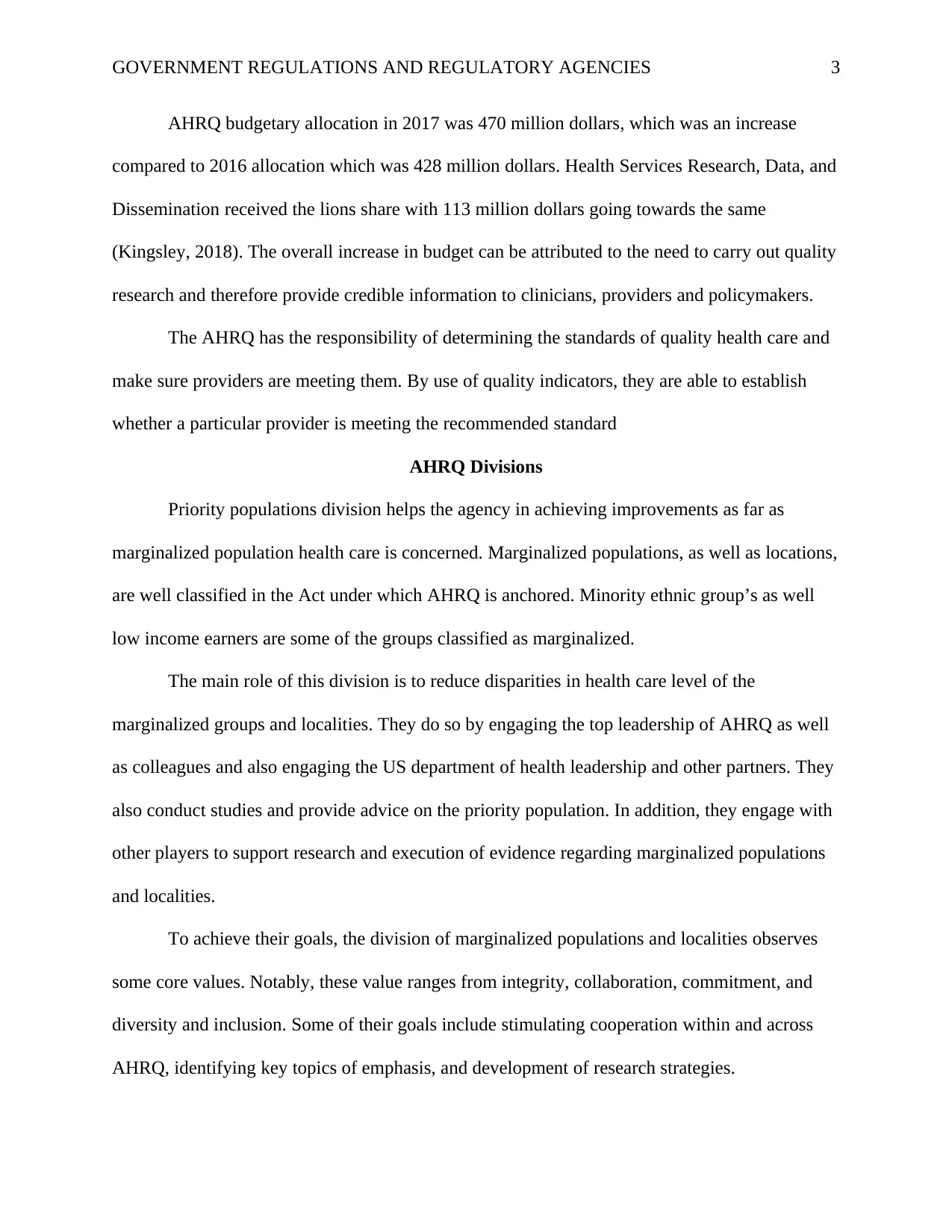
GOVERNMENT REGULATIONS AND REGULATORY AGENCIES 3
AHRQ budgetary allocation in 2017 was 470 million dollars, which was an increase
compared to 2016 allocation which was 428 million dollars. Health Services Research, Data, and
Dissemination received the lions share with 113 million dollars going towards the same
(Kingsley, 2018). The overall increase in budget can be attributed to the need to carry out quality
research and therefore provide credible information to clinicians, providers and policymakers.
The AHRQ has the responsibility of determining the standards of quality health care and
make sure providers are meeting them. By use of quality indicators, they are able to establish
whether a particular provider is meeting the recommended standard
AHRQ Divisions
Priority populations division helps the agency in achieving improvements as far as
marginalized population health care is concerned. Marginalized populations, as well as locations,
are well classified in the Act under which AHRQ is anchored. Minority ethnic group’s as well
low income earners are some of the groups classified as marginalized.
The main role of this division is to reduce disparities in health care level of the
marginalized groups and localities. They do so by engaging the top leadership of AHRQ as well
as colleagues and also engaging the US department of health leadership and other partners. They
also conduct studies and provide advice on the priority population. In addition, they engage with
other players to support research and execution of evidence regarding marginalized populations
and localities.
To achieve their goals, the division of marginalized populations and localities observes
some core values. Notably, these value ranges from integrity, collaboration, commitment, and
diversity and inclusion. Some of their goals include stimulating cooperation within and across
AHRQ, identifying key topics of emphasis, and development of research strategies.
AHRQ budgetary allocation in 2017 was 470 million dollars, which was an increase
compared to 2016 allocation which was 428 million dollars. Health Services Research, Data, and
Dissemination received the lions share with 113 million dollars going towards the same
(Kingsley, 2018). The overall increase in budget can be attributed to the need to carry out quality
research and therefore provide credible information to clinicians, providers and policymakers.
The AHRQ has the responsibility of determining the standards of quality health care and
make sure providers are meeting them. By use of quality indicators, they are able to establish
whether a particular provider is meeting the recommended standard
AHRQ Divisions
Priority populations division helps the agency in achieving improvements as far as
marginalized population health care is concerned. Marginalized populations, as well as locations,
are well classified in the Act under which AHRQ is anchored. Minority ethnic group’s as well
low income earners are some of the groups classified as marginalized.
The main role of this division is to reduce disparities in health care level of the
marginalized groups and localities. They do so by engaging the top leadership of AHRQ as well
as colleagues and also engaging the US department of health leadership and other partners. They
also conduct studies and provide advice on the priority population. In addition, they engage with
other players to support research and execution of evidence regarding marginalized populations
and localities.
To achieve their goals, the division of marginalized populations and localities observes
some core values. Notably, these value ranges from integrity, collaboration, commitment, and
diversity and inclusion. Some of their goals include stimulating cooperation within and across
AHRQ, identifying key topics of emphasis, and development of research strategies.
⊘ This is a preview!⊘
Do you want full access?
Subscribe today to unlock all pages.

Trusted by 1+ million students worldwide
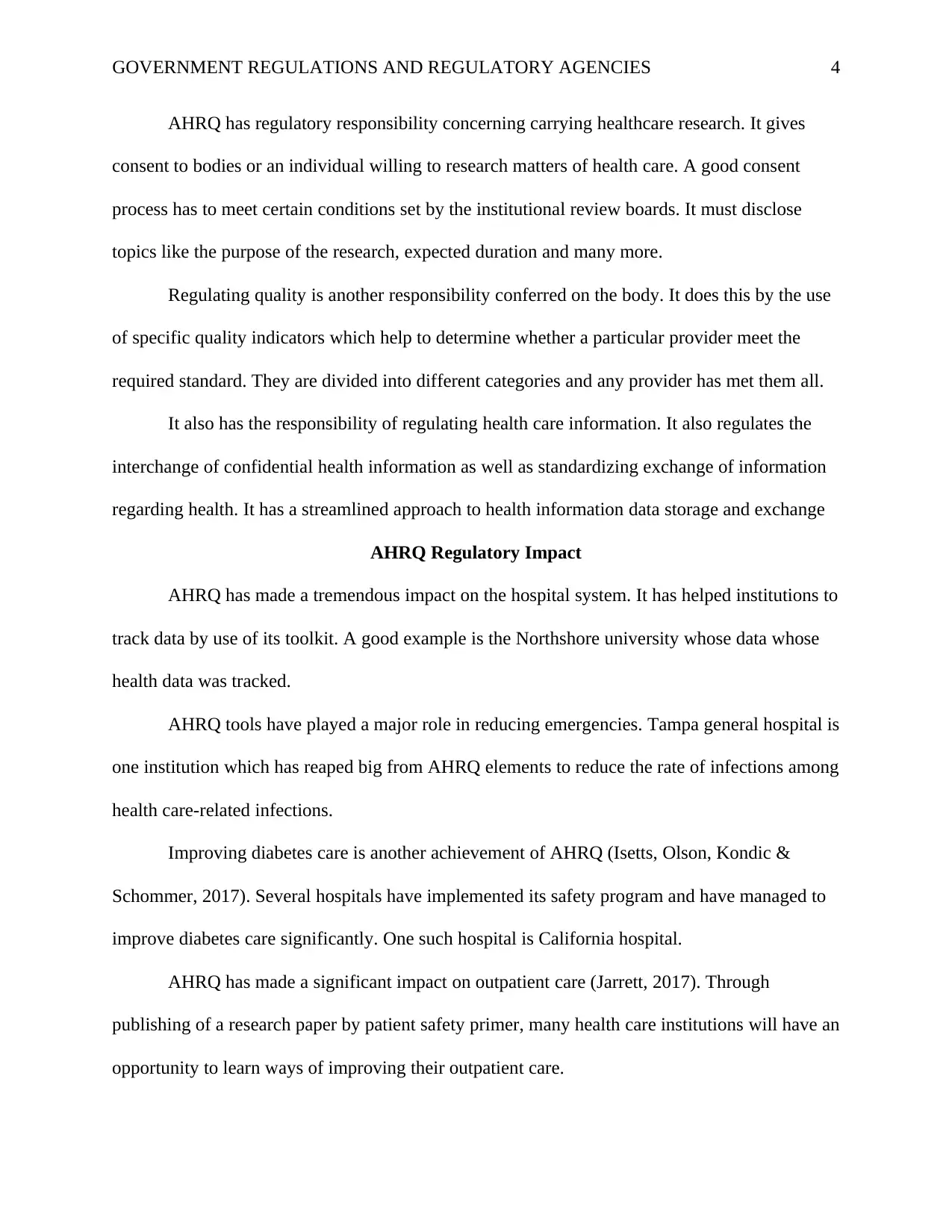
GOVERNMENT REGULATIONS AND REGULATORY AGENCIES 4
AHRQ has regulatory responsibility concerning carrying healthcare research. It gives
consent to bodies or an individual willing to research matters of health care. A good consent
process has to meet certain conditions set by the institutional review boards. It must disclose
topics like the purpose of the research, expected duration and many more.
Regulating quality is another responsibility conferred on the body. It does this by the use
of specific quality indicators which help to determine whether a particular provider meet the
required standard. They are divided into different categories and any provider has met them all.
It also has the responsibility of regulating health care information. It also regulates the
interchange of confidential health information as well as standardizing exchange of information
regarding health. It has a streamlined approach to health information data storage and exchange
AHRQ Regulatory Impact
AHRQ has made a tremendous impact on the hospital system. It has helped institutions to
track data by use of its toolkit. A good example is the Northshore university whose data whose
health data was tracked.
AHRQ tools have played a major role in reducing emergencies. Tampa general hospital is
one institution which has reaped big from AHRQ elements to reduce the rate of infections among
health care-related infections.
Improving diabetes care is another achievement of AHRQ (Isetts, Olson, Kondic &
Schommer, 2017). Several hospitals have implemented its safety program and have managed to
improve diabetes care significantly. One such hospital is California hospital.
AHRQ has made a significant impact on outpatient care (Jarrett, 2017). Through
publishing of a research paper by patient safety primer, many health care institutions will have an
opportunity to learn ways of improving their outpatient care.
AHRQ has regulatory responsibility concerning carrying healthcare research. It gives
consent to bodies or an individual willing to research matters of health care. A good consent
process has to meet certain conditions set by the institutional review boards. It must disclose
topics like the purpose of the research, expected duration and many more.
Regulating quality is another responsibility conferred on the body. It does this by the use
of specific quality indicators which help to determine whether a particular provider meet the
required standard. They are divided into different categories and any provider has met them all.
It also has the responsibility of regulating health care information. It also regulates the
interchange of confidential health information as well as standardizing exchange of information
regarding health. It has a streamlined approach to health information data storage and exchange
AHRQ Regulatory Impact
AHRQ has made a tremendous impact on the hospital system. It has helped institutions to
track data by use of its toolkit. A good example is the Northshore university whose data whose
health data was tracked.
AHRQ tools have played a major role in reducing emergencies. Tampa general hospital is
one institution which has reaped big from AHRQ elements to reduce the rate of infections among
health care-related infections.
Improving diabetes care is another achievement of AHRQ (Isetts, Olson, Kondic &
Schommer, 2017). Several hospitals have implemented its safety program and have managed to
improve diabetes care significantly. One such hospital is California hospital.
AHRQ has made a significant impact on outpatient care (Jarrett, 2017). Through
publishing of a research paper by patient safety primer, many health care institutions will have an
opportunity to learn ways of improving their outpatient care.
Paraphrase This Document
Need a fresh take? Get an instant paraphrase of this document with our AI Paraphraser
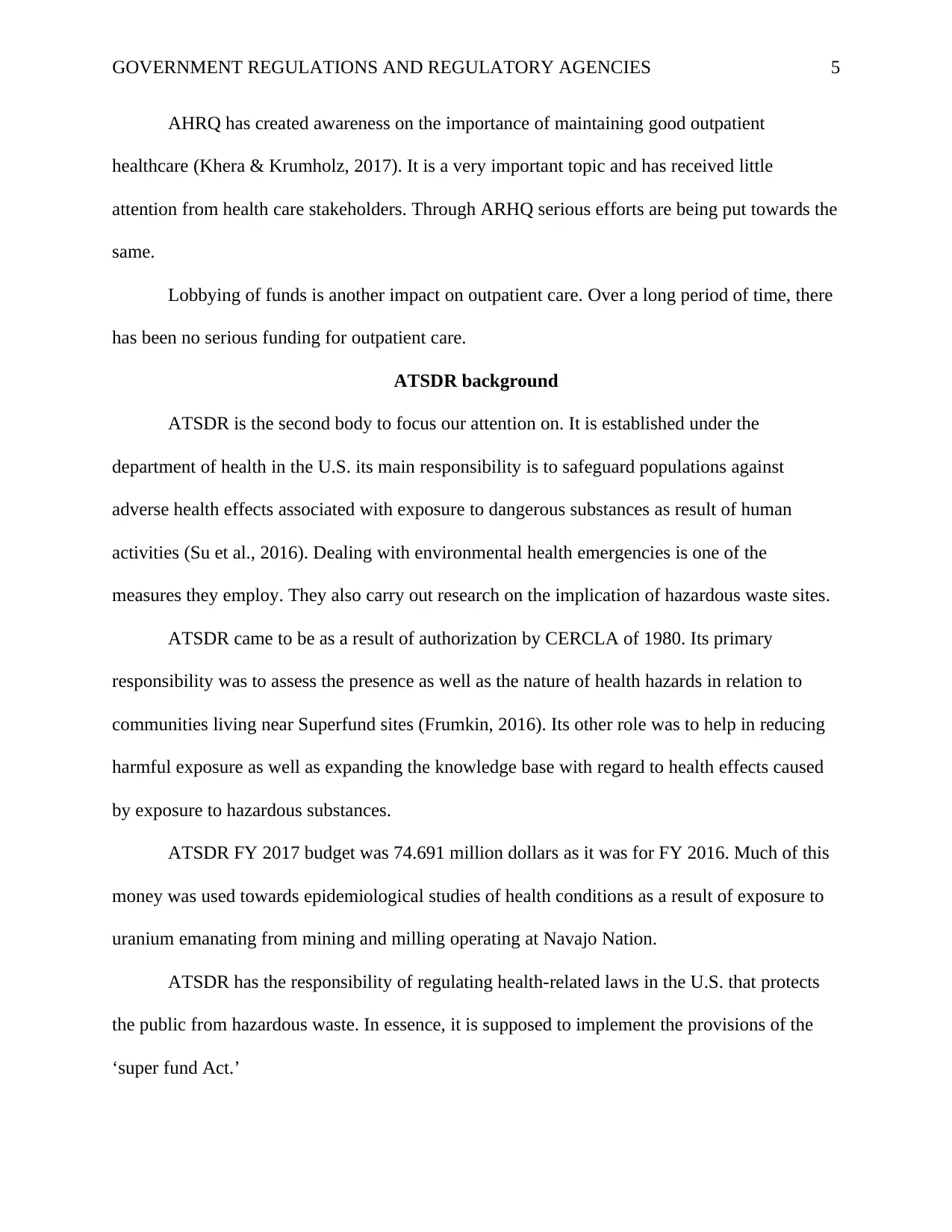
GOVERNMENT REGULATIONS AND REGULATORY AGENCIES 5
AHRQ has created awareness on the importance of maintaining good outpatient
healthcare (Khera & Krumholz, 2017). It is a very important topic and has received little
attention from health care stakeholders. Through ARHQ serious efforts are being put towards the
same.
Lobbying of funds is another impact on outpatient care. Over a long period of time, there
has been no serious funding for outpatient care.
ATSDR background
ATSDR is the second body to focus our attention on. It is established under the
department of health in the U.S. its main responsibility is to safeguard populations against
adverse health effects associated with exposure to dangerous substances as result of human
activities (Su et al., 2016). Dealing with environmental health emergencies is one of the
measures they employ. They also carry out research on the implication of hazardous waste sites.
ATSDR came to be as a result of authorization by CERCLA of 1980. Its primary
responsibility was to assess the presence as well as the nature of health hazards in relation to
communities living near Superfund sites (Frumkin, 2016). Its other role was to help in reducing
harmful exposure as well as expanding the knowledge base with regard to health effects caused
by exposure to hazardous substances.
ATSDR FY 2017 budget was 74.691 million dollars as it was for FY 2016. Much of this
money was used towards epidemiological studies of health conditions as a result of exposure to
uranium emanating from mining and milling operating at Navajo Nation.
ATSDR has the responsibility of regulating health-related laws in the U.S. that protects
the public from hazardous waste. In essence, it is supposed to implement the provisions of the
‘super fund Act.’
AHRQ has created awareness on the importance of maintaining good outpatient
healthcare (Khera & Krumholz, 2017). It is a very important topic and has received little
attention from health care stakeholders. Through ARHQ serious efforts are being put towards the
same.
Lobbying of funds is another impact on outpatient care. Over a long period of time, there
has been no serious funding for outpatient care.
ATSDR background
ATSDR is the second body to focus our attention on. It is established under the
department of health in the U.S. its main responsibility is to safeguard populations against
adverse health effects associated with exposure to dangerous substances as result of human
activities (Su et al., 2016). Dealing with environmental health emergencies is one of the
measures they employ. They also carry out research on the implication of hazardous waste sites.
ATSDR came to be as a result of authorization by CERCLA of 1980. Its primary
responsibility was to assess the presence as well as the nature of health hazards in relation to
communities living near Superfund sites (Frumkin, 2016). Its other role was to help in reducing
harmful exposure as well as expanding the knowledge base with regard to health effects caused
by exposure to hazardous substances.
ATSDR FY 2017 budget was 74.691 million dollars as it was for FY 2016. Much of this
money was used towards epidemiological studies of health conditions as a result of exposure to
uranium emanating from mining and milling operating at Navajo Nation.
ATSDR has the responsibility of regulating health-related laws in the U.S. that protects
the public from hazardous waste. In essence, it is supposed to implement the provisions of the
‘super fund Act.’
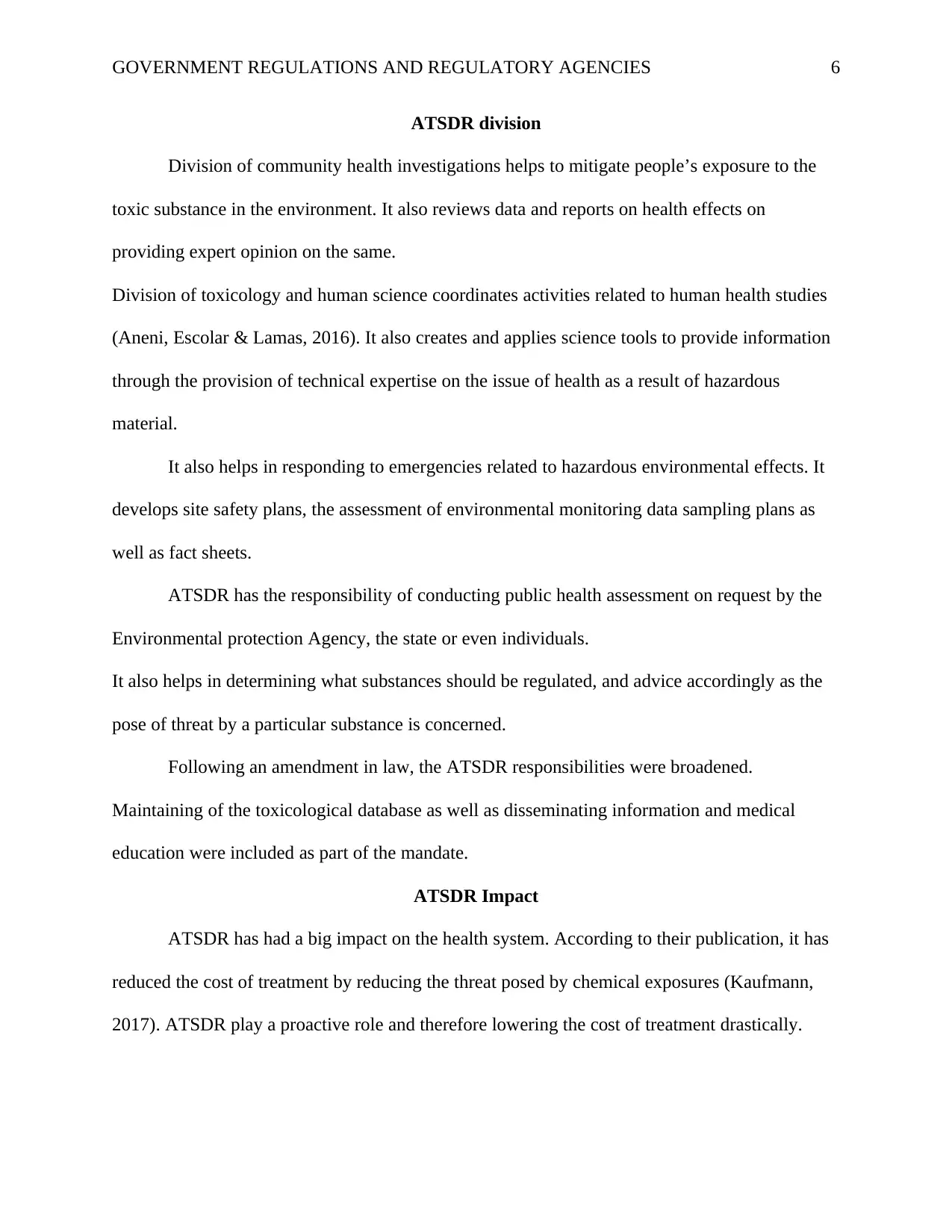
GOVERNMENT REGULATIONS AND REGULATORY AGENCIES 6
ATSDR division
Division of community health investigations helps to mitigate people’s exposure to the
toxic substance in the environment. It also reviews data and reports on health effects on
providing expert opinion on the same.
Division of toxicology and human science coordinates activities related to human health studies
(Aneni, Escolar & Lamas, 2016). It also creates and applies science tools to provide information
through the provision of technical expertise on the issue of health as a result of hazardous
material.
It also helps in responding to emergencies related to hazardous environmental effects. It
develops site safety plans, the assessment of environmental monitoring data sampling plans as
well as fact sheets.
ATSDR has the responsibility of conducting public health assessment on request by the
Environmental protection Agency, the state or even individuals.
It also helps in determining what substances should be regulated, and advice accordingly as the
pose of threat by a particular substance is concerned.
Following an amendment in law, the ATSDR responsibilities were broadened.
Maintaining of the toxicological database as well as disseminating information and medical
education were included as part of the mandate.
ATSDR Impact
ATSDR has had a big impact on the health system. According to their publication, it has
reduced the cost of treatment by reducing the threat posed by chemical exposures (Kaufmann,
2017). ATSDR play a proactive role and therefore lowering the cost of treatment drastically.
ATSDR division
Division of community health investigations helps to mitigate people’s exposure to the
toxic substance in the environment. It also reviews data and reports on health effects on
providing expert opinion on the same.
Division of toxicology and human science coordinates activities related to human health studies
(Aneni, Escolar & Lamas, 2016). It also creates and applies science tools to provide information
through the provision of technical expertise on the issue of health as a result of hazardous
material.
It also helps in responding to emergencies related to hazardous environmental effects. It
develops site safety plans, the assessment of environmental monitoring data sampling plans as
well as fact sheets.
ATSDR has the responsibility of conducting public health assessment on request by the
Environmental protection Agency, the state or even individuals.
It also helps in determining what substances should be regulated, and advice accordingly as the
pose of threat by a particular substance is concerned.
Following an amendment in law, the ATSDR responsibilities were broadened.
Maintaining of the toxicological database as well as disseminating information and medical
education were included as part of the mandate.
ATSDR Impact
ATSDR has had a big impact on the health system. According to their publication, it has
reduced the cost of treatment by reducing the threat posed by chemical exposures (Kaufmann,
2017). ATSDR play a proactive role and therefore lowering the cost of treatment drastically.
⊘ This is a preview!⊘
Do you want full access?
Subscribe today to unlock all pages.

Trusted by 1+ million students worldwide
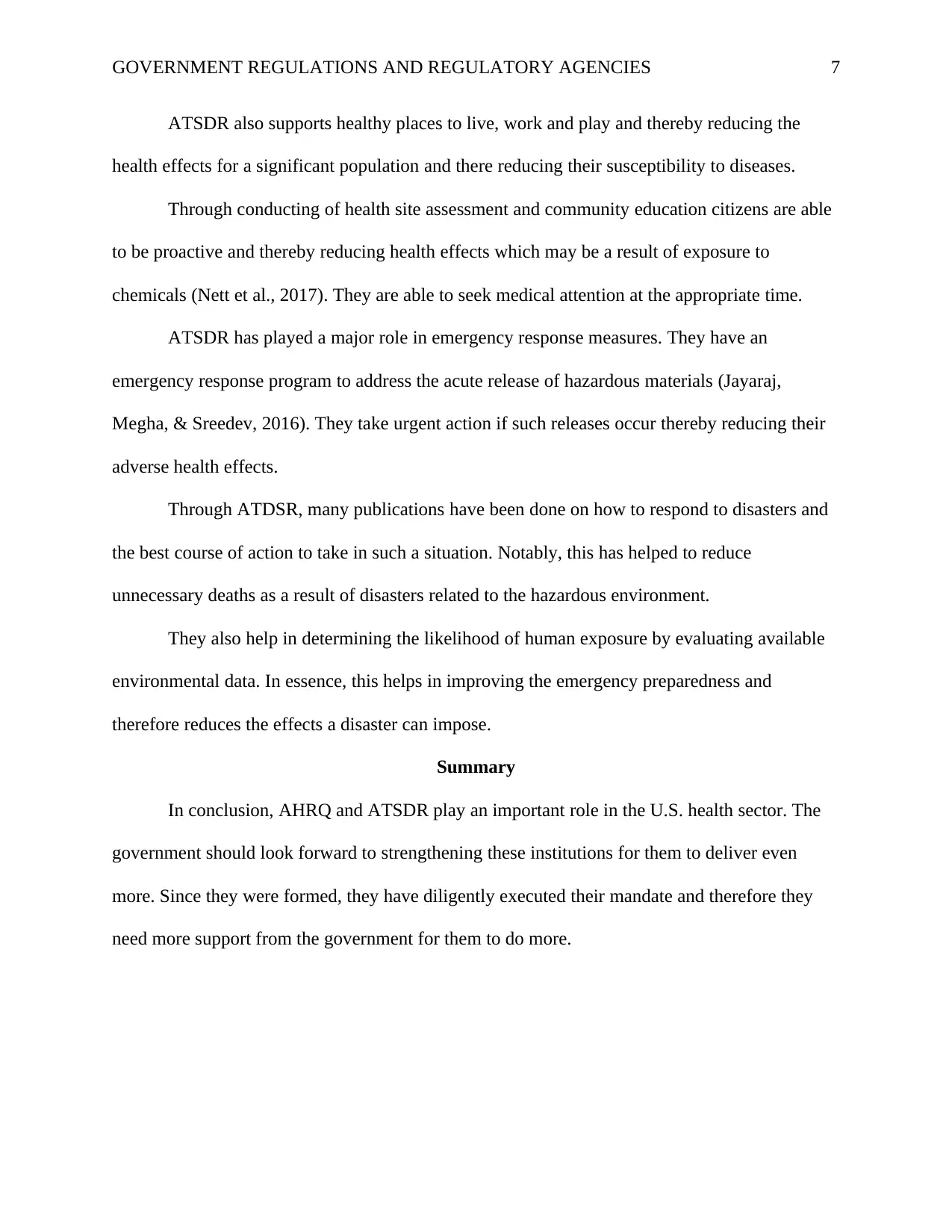
GOVERNMENT REGULATIONS AND REGULATORY AGENCIES 7
ATSDR also supports healthy places to live, work and play and thereby reducing the
health effects for a significant population and there reducing their susceptibility to diseases.
Through conducting of health site assessment and community education citizens are able
to be proactive and thereby reducing health effects which may be a result of exposure to
chemicals (Nett et al., 2017). They are able to seek medical attention at the appropriate time.
ATSDR has played a major role in emergency response measures. They have an
emergency response program to address the acute release of hazardous materials (Jayaraj,
Megha, & Sreedev, 2016). They take urgent action if such releases occur thereby reducing their
adverse health effects.
Through ATDSR, many publications have been done on how to respond to disasters and
the best course of action to take in such a situation. Notably, this has helped to reduce
unnecessary deaths as a result of disasters related to the hazardous environment.
They also help in determining the likelihood of human exposure by evaluating available
environmental data. In essence, this helps in improving the emergency preparedness and
therefore reduces the effects a disaster can impose.
Summary
In conclusion, AHRQ and ATSDR play an important role in the U.S. health sector. The
government should look forward to strengthening these institutions for them to deliver even
more. Since they were formed, they have diligently executed their mandate and therefore they
need more support from the government for them to do more.
ATSDR also supports healthy places to live, work and play and thereby reducing the
health effects for a significant population and there reducing their susceptibility to diseases.
Through conducting of health site assessment and community education citizens are able
to be proactive and thereby reducing health effects which may be a result of exposure to
chemicals (Nett et al., 2017). They are able to seek medical attention at the appropriate time.
ATSDR has played a major role in emergency response measures. They have an
emergency response program to address the acute release of hazardous materials (Jayaraj,
Megha, & Sreedev, 2016). They take urgent action if such releases occur thereby reducing their
adverse health effects.
Through ATDSR, many publications have been done on how to respond to disasters and
the best course of action to take in such a situation. Notably, this has helped to reduce
unnecessary deaths as a result of disasters related to the hazardous environment.
They also help in determining the likelihood of human exposure by evaluating available
environmental data. In essence, this helps in improving the emergency preparedness and
therefore reduces the effects a disaster can impose.
Summary
In conclusion, AHRQ and ATSDR play an important role in the U.S. health sector. The
government should look forward to strengthening these institutions for them to deliver even
more. Since they were formed, they have diligently executed their mandate and therefore they
need more support from the government for them to do more.
Paraphrase This Document
Need a fresh take? Get an instant paraphrase of this document with our AI Paraphraser

GOVERNMENT REGULATIONS AND REGULATORY AGENCIES 8
References
Aneni, E. C., Escolar, E., & Lamas, G. A. (2016). Chronic toxic metal exposure and
cardiovascular disease: mechanisms of risk and emerging role of chelation therapy.
Current atherosclerosis reports, 18(12), 81.
Carpenter, D., Hassell, S., Mardon, R., Fair, S., Johnson, M., Siegel, S., & Nix, M. (2018). Using
learning communities to support adoption of health care innovations. The Joint
Commission Journal on Quality and Patient Safety, 44(10), 566-573.
Frumkin, H. (Ed.). (2016). Environmental health: from global to local. John Wiley & Sons.
Jarrett, M. P. (2017). Patient safety and leadership: Do you walk the walk?. Journal of
Healthcare Management, 62(2), 88-92.
Jayaraj, R., Megha, P., & Sreedev, P. (2016). Organochlorine pesticides, their toxic effects on
living organisms and their fate in the environment. Interdisciplinary toxicology, 9(3-4),
90-100.
Kaufmann, W. (2017). Going by the book: The problem of regulatory unreasonableness.
Routledge.
Khera, R., & Krumholz, H. M. (2017). With great power comes great responsibility: big data
research from the national inpatient sample. Circulation: Cardiovascular Quality and
Outcomes, 10(7), e003846.
Kingsley, T. (2018). ADVOCATING FOR HEALTH SERVICES RESEARCH AND AHRQ.
HEALTH POLICY, 41(10).
Nett, R. J., Cox‐Ganser, J. M., Hubbs, A. F., Ruder, A. M., Cummings, K. J., Huang, Y. C. T., &
Kreiss, K. (2017). Non‐malignant respiratory disease among workers in industries using
References
Aneni, E. C., Escolar, E., & Lamas, G. A. (2016). Chronic toxic metal exposure and
cardiovascular disease: mechanisms of risk and emerging role of chelation therapy.
Current atherosclerosis reports, 18(12), 81.
Carpenter, D., Hassell, S., Mardon, R., Fair, S., Johnson, M., Siegel, S., & Nix, M. (2018). Using
learning communities to support adoption of health care innovations. The Joint
Commission Journal on Quality and Patient Safety, 44(10), 566-573.
Frumkin, H. (Ed.). (2016). Environmental health: from global to local. John Wiley & Sons.
Jarrett, M. P. (2017). Patient safety and leadership: Do you walk the walk?. Journal of
Healthcare Management, 62(2), 88-92.
Jayaraj, R., Megha, P., & Sreedev, P. (2016). Organochlorine pesticides, their toxic effects on
living organisms and their fate in the environment. Interdisciplinary toxicology, 9(3-4),
90-100.
Kaufmann, W. (2017). Going by the book: The problem of regulatory unreasonableness.
Routledge.
Khera, R., & Krumholz, H. M. (2017). With great power comes great responsibility: big data
research from the national inpatient sample. Circulation: Cardiovascular Quality and
Outcomes, 10(7), e003846.
Kingsley, T. (2018). ADVOCATING FOR HEALTH SERVICES RESEARCH AND AHRQ.
HEALTH POLICY, 41(10).
Nett, R. J., Cox‐Ganser, J. M., Hubbs, A. F., Ruder, A. M., Cummings, K. J., Huang, Y. C. T., &
Kreiss, K. (2017). Non‐malignant respiratory disease among workers in industries using
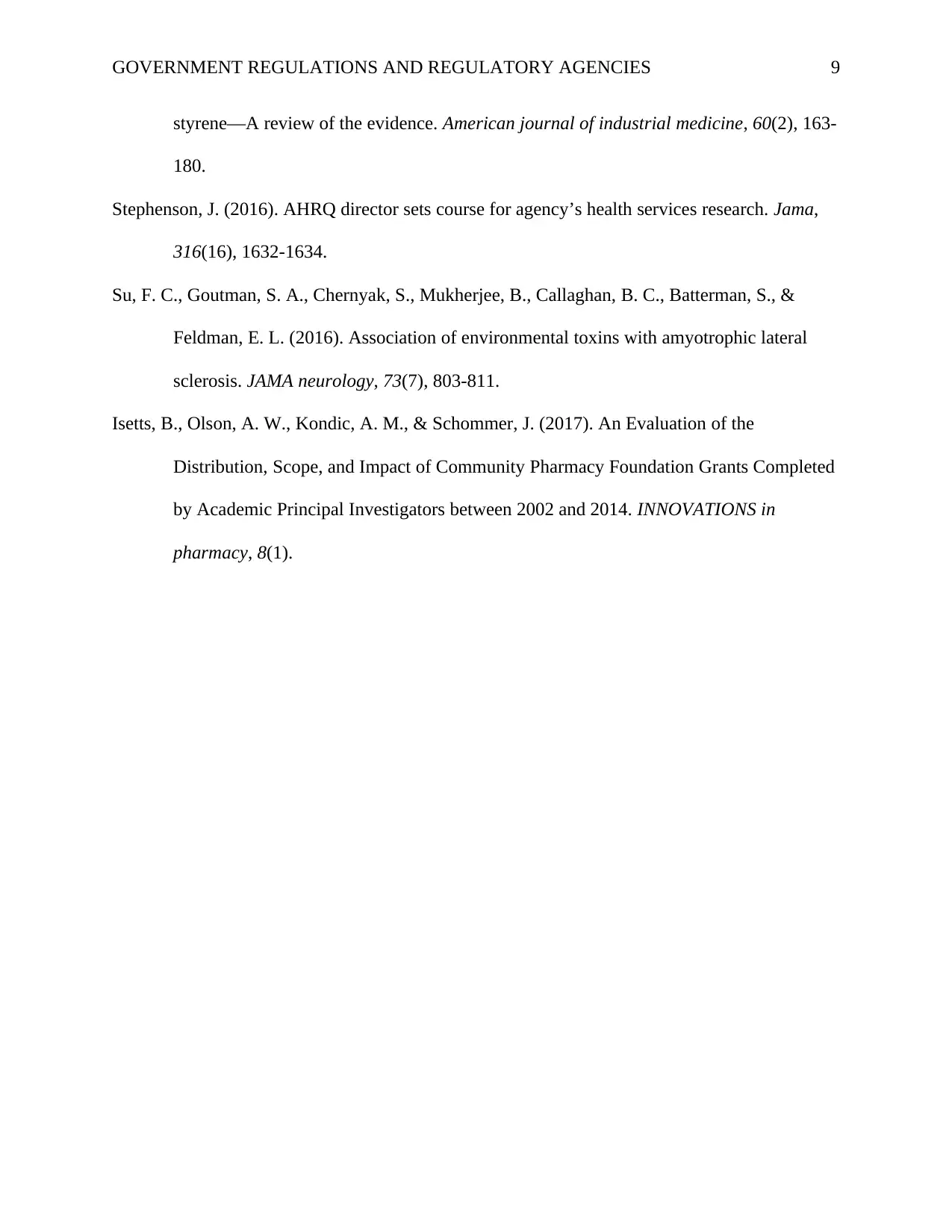
GOVERNMENT REGULATIONS AND REGULATORY AGENCIES 9
styrene—A review of the evidence. American journal of industrial medicine, 60(2), 163-
180.
Stephenson, J. (2016). AHRQ director sets course for agency’s health services research. Jama,
316(16), 1632-1634.
Su, F. C., Goutman, S. A., Chernyak, S., Mukherjee, B., Callaghan, B. C., Batterman, S., &
Feldman, E. L. (2016). Association of environmental toxins with amyotrophic lateral
sclerosis. JAMA neurology, 73(7), 803-811.
Isetts, B., Olson, A. W., Kondic, A. M., & Schommer, J. (2017). An Evaluation of the
Distribution, Scope, and Impact of Community Pharmacy Foundation Grants Completed
by Academic Principal Investigators between 2002 and 2014. INNOVATIONS in
pharmacy, 8(1).
styrene—A review of the evidence. American journal of industrial medicine, 60(2), 163-
180.
Stephenson, J. (2016). AHRQ director sets course for agency’s health services research. Jama,
316(16), 1632-1634.
Su, F. C., Goutman, S. A., Chernyak, S., Mukherjee, B., Callaghan, B. C., Batterman, S., &
Feldman, E. L. (2016). Association of environmental toxins with amyotrophic lateral
sclerosis. JAMA neurology, 73(7), 803-811.
Isetts, B., Olson, A. W., Kondic, A. M., & Schommer, J. (2017). An Evaluation of the
Distribution, Scope, and Impact of Community Pharmacy Foundation Grants Completed
by Academic Principal Investigators between 2002 and 2014. INNOVATIONS in
pharmacy, 8(1).
⊘ This is a preview!⊘
Do you want full access?
Subscribe today to unlock all pages.

Trusted by 1+ million students worldwide
1 out of 9
Related Documents
Your All-in-One AI-Powered Toolkit for Academic Success.
+13062052269
info@desklib.com
Available 24*7 on WhatsApp / Email
![[object Object]](/_next/static/media/star-bottom.7253800d.svg)
Unlock your academic potential
Copyright © 2020–2025 A2Z Services. All Rights Reserved. Developed and managed by ZUCOL.





